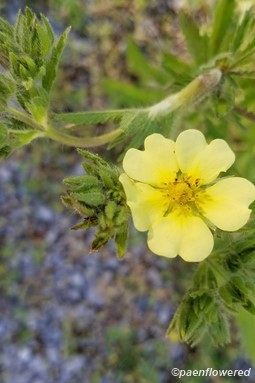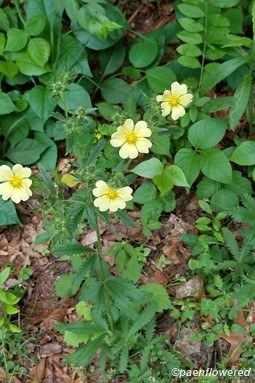Potentilla recta
Introduced hairy cinquefoil with petals of sulphur color
Potentilla recta sulfur cinquefoil
This perennial wildflower is a member of the rose family. It was accidentally introduced to America from the Mediterranean region of Eurasia at an early date. It is an erect, hairy species with many leaves and some branches. The leaves are palmately divided into five to seven leaflets. Each of these is relatively narrow and toothed. The upper leaves are smaller, have no stalks and may only have three leaflets.
The flowers are larger and more attractive than other cinquefoil species (1/2 to 1 inch in diameter). These are pale yellow, have five notched, heart-shaped petals and five green sepals. They have about 30 stamens. The flowers are borne in a flat cluster at the end of the stem. The fruit is dry and seed-like and give the plant one of its common name. Seeds are its only means of reproduction. The plant grows to a height of 1-2 feet and is found on roadsides and fields throughout North America except for the desert southwest and the Arctic. They grow in sunny areas and are tolerant of many types of soils. The plant blooms from June to August.
This species has little value in agriculture since cattle will often avoid eating it. In some areas, especially in the Pacific Northwest, it is considered a noxious weed that can suppress native species. There are few effective eradication procedures. The color of its flowers is responsible for the alternate common name sulfur cinquefoil. White and gold color variations are known. There are several other similar species of cinquefoils in this area. The two most common are the dwarf cinquefoil (P. canadensis) and common cinquefoil (P. simplex). They differ primarily in the size of the flowers and the shape of the leaflets.
Habitat & Range
Grows in fields, meadows, along roadsides.
Present throughout the state.
Range: Across all of North America except for the desert southwest and the Arctic.
Wetland code: Not Classified
Phenology
Flowers June to August.








Comments
Have you spotted this plant in your area? We'd love to hear about your experience! Share your comments or questions about the plant below. Comments are moderated before posting.